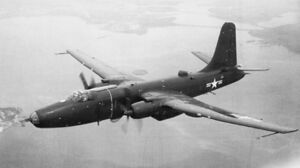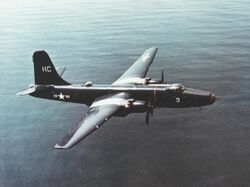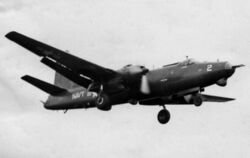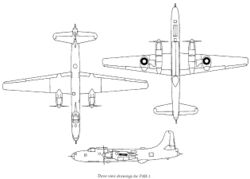Engineering:Martin P4M Mercator
| P4M Mercator | |
|---|---|

| |
| United States Navy P4M-1 | |
| Role | Patrol bomber |
| National origin | United States |
| Manufacturer | Martin |
| First flight | 20 October 1946 |
| Introduction | 1950 |
| Retired | 1960 |
| Status | Retired |
| Primary user | United States Navy |
| Number built | 21 |
The Martin P4M Mercator was a maritime reconnaissance aircraft built by the Glenn L. Martin Company. The Mercator was an unsuccessful contender for a United States Navy requirement for a long-range maritime patrol bomber, with the Lockheed P2V Neptune chosen instead. It saw a limited life as a long-range electronic reconnaissance aircraft. Its most unusual feature was that it was powered by a combination of piston engines and turbojets, the latter being in the rear of the engine nacelles.
Design and development
Work began on the Model 219 in 1944, as a replacement for the PB4Y Privateer long-range patrol bomber, optimised for long range minelaying missions, with the first flight being on 20 October 1946.[1] A large and complicated aircraft, it was powered by two Pratt & Whitney R4360 Wasp Major 28-cylinder radial engines. To give a boost during takeoff and combat, two Allison J33 turbojets were fitted in the rear of the two enlarged engine nacelles, the intakes being beneath and behind the radial engines.[2] The jets, like those on most other piston/jet hybrids, burned gasoline instead of jet fuel which eliminated the need for separate fuel tanks.
A tricycle undercarriage was fitted, with the nosewheel retracting forwards. The single-wheel main legs retracted into coverless fairings in the wings, so that the sides of the wheels could be seen even when retracted. The wings themselves, unusually, had a different airfoil cross-section on the inner wings than the outer.
Heavy defensive armament was fitted, with two 20 mm (.79 in) cannon in an Emerson nose turret and a Martin tail turret, and two 0.5 in (12.7 mm) machine guns in a Martin dorsal turret. The bomb bay was, like British practice, long and shallow rather than the short and deep bay popular in American bombers. This gave greater flexibility in payload, including long torpedoes, bombs, mines, depth charges or extended-range fuel tanks.[3]
Operational history
The US Navy chose the smaller, simpler, cheaper and better performing P2V Neptune for the maritime patrol requirement, but nineteen aircraft were ordered in 1947 for high-speed minelaying purposes. The P4M entered service with Patrol Squadron 21 (VP-21) in 1950, the squadron deploying to NAS Port Lyautey in French Morocco.[4] It remained in use with VP-21 until February 1953.[5]
From 1951, the 18 surviving production P4Ms were modified for the electronic reconnaissance (or SIGINT, for signals intelligence) mission as the P4M-1Q, to replace the PB4Y-2 Privateer. The crew was increased to 14 and later 16 to operate all the surveillance gear, and the aircraft was fitted with a large number of different antennae.[6]
Starting in October 1951, electronic surveillance missions were flown from U.S. Naval Station Sangley Point in the Philippines , later from Naval Air Station Iwakuni, Japan , and Naval Air Station Atsugi, Japan, by a secretive unit that eventually gained the designation Fleet Air Reconnaissance Squadron One (VQ-1). Long missions were flown along the coast (about 30 NM offshore) of Vietnam, China, North Korea and the eastern Soviet Union, and were of a highly secret nature; the aircraft sometimes masqueraded as regular P2V Neptunes in radio communications, and often flew with false serial numbers (Bureau Numbers) painted under the tail. Operational missions were always flown at night, during the dark with the moon when possible, and with no external running lights.[7]
Losses
- On 8 March 1951 Mercator flew into Atlantic Ocean off Florida-4 killed.[8]
- On 6 February 1952, ditched north of Cyprus at night, out of fuel, with no power, losing only the Aircraft Commander/pilot after they were in the water (See United States Naval Institute, Naval History, March/April 1997). The crew was rescued by HMS Chevron.[9]
- On 22 August 1956 one Mercator was shot down near Shanghai by Chinese fighters of the 2nd Aviation Division,[10] with its crew of 16 all killed.[11]
- On November 19, 1957 Mercator lost in accident[12]
- On 6 January 1958,[13] P4M-1Q of JQ-3[14] crashed at Ocean View, Virginia, when it lost an engine on approach to NAS Norfolk, Virginia, killing four crew and injuring three civilians.[15]
- On 16 June 1959 a P4M-1Q was attacked by two North Korean MiG-17s with heavy damage and serious injury to the tail gunner.[16]
- On 19 January 1960, VQ-2 P4M-1Q JQ-16 (buno 124365) crashed en route to Adana AFB killing all 16 aircrew. The RAF Mountain Rescue Team based at Nicosia, Cyprus recovered the bodies of 12 crew members before being forced to leave the recovery of the remaining bodies/parts until the spring. the Mercators were replaced by the EA-3B Skywarrior, which, being carrier-based, had a greater degree of flexibility and the larger Lockheed WV-2Q Warning Star. Final withdrawal from service was in 1960 after which all of the remaining P4Ms were scrapped.[17]
Variants
- XP4M-1
- Two prototype aircraft with two R-4360-4 engines.
- P4M-1
- Production aircraft with two R-4360-20A engines, 19 built.
- P4M-1Q
- P4M-1s redesignated when modified for radar countermeasures.
Operators
 United States
United States
- United States Navy
Specifications (P4M-1 Mercator)
Data from United States Navy aircraft since 1911,[18] Naval Fighters #37: Martin P4M-1/-1Q Mercator[19]
General characteristics
- Crew: 9 (patrol bomber); 16 (Electronic reconnaissance)
- Length: 86 ft 2.5 in (26.276 m)
- Wingspan: 114 ft 0 1⁄16 in (34.749 m)
- Height: 29 ft 2 1⁄16 in (8.892 m)
- Wing area: 1,311 sq ft (121.8 m2)
- Aspect ratio: 9.87
- Airfoil: root: NACA 2417 (17%); tip: NACA 2412 (12%)
- Empty weight: 48,536 lb (22,016 kg)
- Gross weight: 83,378 lb (37,820 kg)
- Fuel capacity:
- Fuel (115/145 Avgas): 3,500 US gal (2,900 imp gal; 13,000 l) total in 4 wing tanks and 4 auxiliary tanks in the bomb bay
- Oil: 216 US gal (180 imp gal; 820 l) in 2 nacelle tanks
- Water 9 US gal (7.5 imp gal; 34 l) in 2 nacelle tanks
- Powerplant: 2 × Pratt & Whitney R-4360-20A Wasp Major 28-cylinder air-cooled radial piston engines, 3,250 hp (2,420 kW) each with water injection
- (XP4M-1: 2,975 hp (2,218 kW) R-4360-4)
- Powerplant: 2 × Allison J33-A-10A turbojet engines, 4,600 lbf (20 kN) thrust each
- (XP4M-1: 3,825 lbf (17,010 N) J33-A-17)
- Propellers: 4-bladed Hamilton Standard, 15 ft 2 in (4.62 m) diameter reversible-pitch constant-speed propellers
Performance
- Maximum speed: 410 mph (660 km/h, 360 kn) at 20,100 ft (6,100 m)
- Range: 2,840 mi (4,570 km, 2,470 nmi)
- Ferry range: 4,230 mi (6,810 km, 3,680 nmi) with bomb-bay auxiliary tanks fitted
- Service ceiling: 34,600 ft (10,500 m)
Armament
- 4 × 20 mm (0.787 in) cannon in nose and tail turrets
- 2 × 0.5 in (12.70 mm) machine guns in dorsal turret
- Up to 12,000 lb (5,400 kg) of bombs, mines, depth charges, or torpedoes
Avionics
- AN/APS-33 search radar
See also
Aircraft of comparable role, configuration and era
Related lists
- List of military aircraft of the United States (naval)
References
- ↑ Lake and Dorr 2000, p.139.
- ↑ Lake and Dorr 2000, pp. 138–139.
- ↑ Dorr and Burgess 1993, pp. 216–217.
- ↑ Dorr and Burgess 1993, p.217.
- ↑ Roberts 2000, p.125.
- ↑ Lake and Dorr 2000, pp. 141–142.
- ↑ Dorr and Burgess 1993, pp. 217, 220.
- ↑ J. Baugher listing
- ↑ [The aircraft were also operated out of Morocco by VQ-2; One garbled version of this incident is that this aircraft was intercepted near Ukrainian airspace and shot down, crashing into the Mediterranean Sea with the loss of all crew. (Former seaman who served in the Med)
- ↑ "空2师(歼击航空兵)". 2012-03-19. http://www.plaaf.net/Air-Force-Deploy/Guangzhou-Military-Region-Deploym/201004/667.html.
- ↑ Dorr and Burgess 1993, pp. 220–221.
- ↑ J. Baugher listing
- ↑ "US Navy and US Marine Corps BuNos--Third Series (120342 to 126256)". http://www.joebaugher.com/navy_serials/thirdseries13.html.
- ↑ "Archived copy". http://www.portlyautey.com/ECM-2.htm.
- ↑ Associated Press, "Four Missing In Air Crash", The Anderson Independent, Anderson, South Carolina, Tuesday 7 January 1958, Volume 41, Number 99, page 1.
- ↑ Dorr and Burgess 1993, pp. 221–222.
- ↑ Dorr and Burgess 1993, p.222.
- ↑ Swanborough, Gordon; Bowers, Peter M. (1976). United States Navy aircraft since 1911 (2nd ed.). Annapolis: Naval Institute Press. p. 513. ISBN 0870217925.
- ↑ Ginter, Steve (December 1996). Martin P4M-1/-1Q Mercator. California: S. Ginter. ISBN 0-942612-37-X.
- Dorr, Robert F. and Richard R. Burgess. "Ferreting Mercators". Air International, October 1993, Vol.45, No. 4. ISSN 0306-5634. pp. 215–222.
- Lake, Jon and Robert F. Dorr. "Martin P4M Mercator". Wings of Fame. Volume 19. London:Aerospace Publishing, 2000. ISBN:1-86184-049-7. pp. 138–149.
- Roberts, Michael D. Dictionary of American Naval Aviation Squadrons:Volume 2: The History of VP, VPB, VP(HL) and VP(AM) Squadrons. Washington, DC:Naval Historical Center, 2000.




